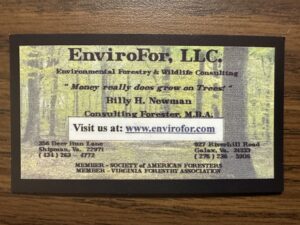Investing in Virginia Timber Lands
Folks own property for a variety of reasons. Some for pleasure, some for profit, but almost all out of a sense of ownership. Forest landownership provides multiple uses, benefits, and products that may be consumptive or non-consumptive in nature.
Consumptive uses would include harvesting or collecting products from the forest, while non-consumptive uses might include camping, hiking, photography, or bird watching.
If income production or financial profit is a goal, then ownership might be as an investment. The value of real estate has long been thought to be a hedge against inflation. The value of timber as a commodity produced by the forest compares favorably against other long-term investments as well. Forest economists have long thought of timber production as yielding an average annual return of about 10%. Historically, the stock market has produced similar results on an average annual basis.
Savy investors may then purchase timberland as a way to diversify their investment portfolio as another method of “spreading investment risk.” Not everyone wants the burden of personal land ownership, but enjoy the opportunity to reap the rewards. Hence, the development of the Timberland Investment Management Organization or TIMO as an investment vehicle. A TIMO operates very much like a mutual fund. The key element is that these forests are intensively and professionally managed to produce a satisfactory return on investment (ROI). Interestingly, the largest private landowner in Virginia is an insurance company TIMO. These organizations would not exist if the ROI were not comparable to other investments.
Tree growth works a lot like money invested into a bank or mutual fund account. The expectation is that it will grow over time at a satisfactory rate called interest. Future tree growth over time (interest) can be predicted based on previous growth. To measure growth, foresters can examine the annual growth for a tree or a stand of trees as a percentage of total growth. Growth at a specified rate over time is called compounding. A $100 invested at 5% interest over 10 years would yield $162.89 using a compound interest formula.
A tree worth $100 stumpage (value received by the landowner if the tree were sold to a buyer) grows at 5% per year for 10 years would yield $162.89. Assuming a tree value in 10 years of $142.89 would yield a real interest rate (a real interest rate is one that does not include inflation.) of 3.6%. If a minimum acceptable interest rate of 5% were desired, this tree would be underachieving for this landowner. The landowner could decide to harvest the tree because it is financially mature. Assuming a tree value in 10 years of $182.89 would yield a real interest rate of 6.2%. This rate is higher than the threshold minimum rate of 5%, so this tree to continue the growth process for several years.
Applying this concept to a stand of Loblolly pine trees could result in the following calculation of Net Present Value (NPV):
Present Value (PV) of revenue;
Discount Formula PV ($/acre)
Thin at age 20 years $300(1/1.05)20th power $ 113.07
Thin at age 30 years $600(1/1.05)30th power $ 138.82
Clearcut at age 50 years $2,500(1/1.05)50th power $ 218.01
Total PV – Revenues $ 469.91
Present Value (PV) of expenses;
Discount Formula PV($/acre)
Planting(w/o site) $ – 50 $ -50.00
preparation
Hardwood control $ -60(1/1.05)2nd power $ -54.42
(chemical application)
Administrative or $ -5((1.05)50th power – 1/ $ -86.28
Ownership costs .05(1.05)50th power)) + $5
Total PV – Expenses $ -190.70
NPV $ 279.21
Internal rate of return (IRR) is an investment’s actual rate of return. The IRR is the discount rate when the investment expenses and revenues are equal. At that point NPV is equal to $0. NPV and IRR are two decision-making criteria widely utilized by forest landowners.
Benefit/cost ratio is another way to express the PV of expenses vs. revenues. Dividing revenues by expenses is a “quick and dirty” evaluation tool for an investment. A B/C ratio greater than 1 shows that benefits exceed costs, indicating a wise investment decision. A B/C ratio of less than 1 indicates expenses exceed the benefit hoped for by undergoing the investment or practice. These funds could have been allocated toward a better investment.
A forest landowner should consider the utilization of a consulting forester experienced with financial analysis to assist with implementation of forest management activities prior to harvesting timber. An intermediate thinning of either pine or hardwood stands would remove trees that have little opportunity to develop future growth above the minimum acceptable rate of return. The best, most productive trees would be allowed to further develop. These trees may be able to increase volume, grade, and market value concurrently. This could allow significant return above the desired minimum rate of return. A regeneration harvest should be considered when financial maturity has been maximized and leaving such stands of trees would result in a rate of return less than the acceptable minimum. This concept is entirely different from that of biological maturity that simply stated is the general lifespan of a tree or stand of trees.
Forest landowners goals and objectives are the major considerations when developing a forest management plan. A plan is the blueprint for conducting activities within the forest and should be conceived well in advance of consumptive forest activities.
Money REALLY does grow on trees!
"What is YOUR timber worth?"
Contact EnviroFor, LLC.
EnviroFor, LLC.
356 Deer Run Lane
Shipman, Virginia 22971
(434) 263-4772
enviroforllc@netscape.net

